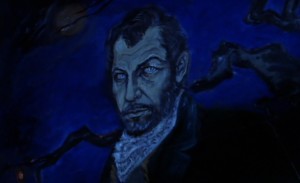Why Found-Again? Like Vertigo from earlier this year, it’s hard to tell—given the combined forces of old Saturday movies, horror documentaries and Mel Brooks parodies—whether I’ve actually seen Frankenstein before. I’m not going to let that stop me, though. I can “IT’S ALIVE!!!” with the best of them.
The Premise: Blah, blah, body-snatching, meddling with blah that man was never meant to blah, neglecting the love of your life for MAD SCIENCE!, mayhem, fire bad, blah.

You may gather from the above that I am not completely happy with my viewing, or indeed with the Frankenstein(‘s monster) idea in general: like Romero-style zombies, it’s a horror genre for which the symbolic richness of the idea far outweighs any interest I have in watching the actual product. I haven’t even seen the Kenneth Branagh adaptation, and that was made when I still thought of Branagh as a minor deity.
And now that I’ve finished it, I think I must not have watched the 1931 Frankenstein before after all: finding out that the brain-stealing scene in the Mel Brooks movie was lifted nearly wholesale came as an almost physical shock.

Even so, I found the monster’s electric birth and subsequent misery very moving…only to run up against the angry mob at the end. Like the brain theft, it was familiar—but it seems it’s a lot harder to get the mood back from memories of Transylvania 6-5000.

Other random thoughts:
- I love the futuristic font the movie title is written in at the beginning, even though most of the rest of the film seems terribly old-fashioned by comparison.
- Remember when I said that if you don’t love the character Rachel in Highlander, you are a terrible person? The same goes for Boris Karloff. I don’t even hold a grudge over the very misnamed The Man They Could Not Hang. (They definitely did, to death and possibly beyond; it just didn’t take.)
- Henry Frankenstein—Henry??—seems like a man who could profitably take relationship advice from Werewolf of London’s Wilfred Glendon. It’s that bad.
- For a guy getting choked to death, Fritz (known to the popular consciousness as Igor) sure can scream.
- I am half-convinced that after his collapse, Henry goes to the same sanitarium James Bond repaired to after the unfortunate genital incident in Casino Royale.
- Imagine a mob of angry villagers, each wearing my grandfather’s hat.

The Verdict: It’s not Frankenstein, it’s me. I made it through Halloween even though I’d seen it all before, Charade wasn’t ruined because American Dreamer ripped off its beginning, but I had a very hard time with this one. It’s a shame—this is the only Frankenstein movie I’ve ever watched that wasn’t a bride-of movie or a parody of some sort—but it just isn’t my cup of tea.
Might go well with: Bratwurst, Abbott & Costello Meet Frankenstein, millinery.
Next time: The monster hits keep coming when The Quest for Monday returns!





